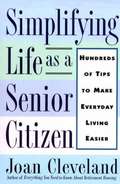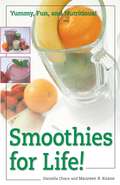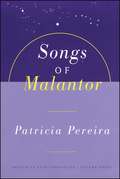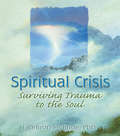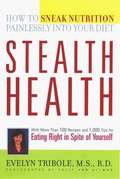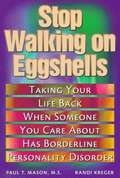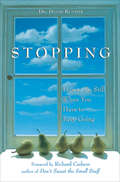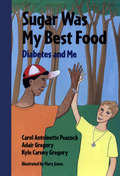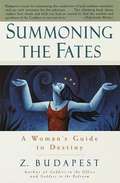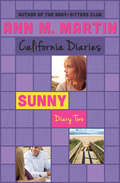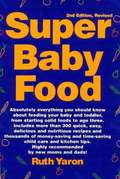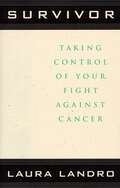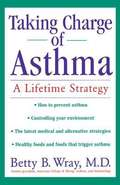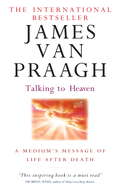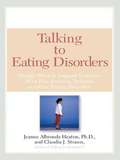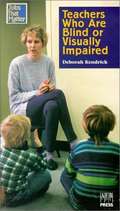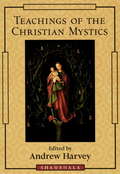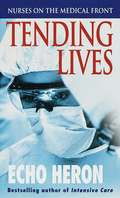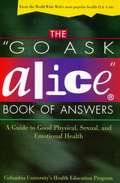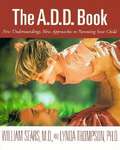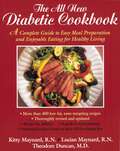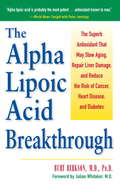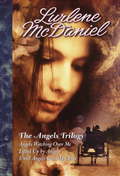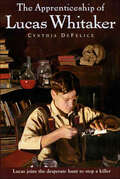- Table View
- List View
Simplifying Life as a Senior Citizen: Hundreds of Tips to Make Everyday Living Easier
by Joan ClevelandProviding solutions for common problems that afflict the daily lives of the elderly, this book presents information to help readers save time, money, frustration, and pain. Includes chapters of tips for managing vision loss, hearing loss and loss of mobility. The book provides chapters of easily read one-line tips that address a variety of broad as well as specific situations.
Smoothies for Life!: Yummy, Fun, and Nutritious!
by Daniella Chace Maureen B. KeaneBlend Your Way to Better Health!Join the millions of health-conscious individuals who have already discovered the tasty, nutritional, revitalizing goodness of smoothies. In Smoothies for Life, Daniella Chace and Maureen Keane (coauthor of the million-copy bestseller Juicing for Life) show you how to make high-energy, delicious smoothies right in your own home! All you need is a blender (or food processor), a few, simple ingredients, and you're ready to embark on a new taste and nutrition adventure. Learn how you can:·Beat fatigue with Mocha Magic ·Build athletic endurance with Tropical Elixir ·Lose weight with Peachy Almond Freeze ·Boost immunity with Rasanana Berry ·Reduce stress with Ginseng Soother ·Improve your memory with Pink Hurricane ·Detoxify your body with Watermelon Cooler ·And much more!These tantalizing smoothies contain creative combinations of antioxidant-rich fruits, healing tinctures, flavorful extracts, and natural sweeteners -- and they are always delicious. Once you start, you'll be drinking these smoothies for life!Includes information for adding revitalizing herbs such as ginkgo, echinacea, goldenseal, and kava!From the Trade Paperback edition.
Songs Of Malantor: The Arcturian Star Chronicles Volume Three (The Arcturian Star Chronicles)
by Patricia PereiraIn 1987, medical transcriptionist Patricia Pereira suddenly started receiving telepathic communications from the star Arcturus and was requested to begin a series of galactically inspired manuscripts. The mission of this series of books is to awaken us to our individual and collective spiritual obligation for the health and well-being of our planet and all creatures who live upon her. Philosophical in cope, the essays in these books provide pragmatic, practical suggestions for emotional, mental physical, and spiritual transformation. They remind us of our familial relationships to beings of light who inhabit the great star nations. Songs of Malantor offers cosmic information of expanded complexity to assist humans in the times of change and to prepare them for citizenship in the greater galactic community. Malantor is best describes as a fifth- and sixth-dimensional being of light from Arcturus, the primary star of the Boötes system. Malantor is a creator of melodious lyrics, an Arcturian poet and intergalactic counselor-teacher who volunteered for Earth assignment. He resides on board the Intergalactic Brotherhood’s principal mother ship, Marigold—City of Lights.
Spiritual Crisis: Surviving Trauma to the Soul
by J Lebron McbrideIt’s no revelation that in today’s world many people suffer from some form of spiritual crisis. But, fortunately, there is hope. In Spiritual Crisis: Surviving Trauma to the Soul, you’ll discover how you can reverse the impact of spiritual crisis and apply healing balm to the traumatized soul. A comprehensive, real-life approach to spiritual care, it gives you the understanding necessary to put a lid on the daily chaos that seeks to destroy those whose lives have been shattered by tragedy, terror, and disillusionment.Written from the perspective of a compassionate professional who has navigated the dark and turbulent waters of his own spiritual crises, Spiritual Crisis represents a loving cross-section of aid from the fields of pastoral theology, psychology, and health care. Christians and non-Christians alike will benefit from its frank approach to aiding troubled souls through the tough times of belief transition, loss of faith, and potentially damaging extremes in living and thinking. Specifically, you’ll read about: understanding the effects and roots of spiritual crisis and trauma coping with loss counteracting disillusionment with the church negotiating belief transitions dealing with religious burnout intervening in denominational identity crisesOftentimes, it’s hard to know what will make a loved one survive or succumb to the impact of seemingly insurmountable personal emergencies. However, this book is a “call to care” that will enable you to help others turn back the tide of debilitating hardship in their lives and restore the tempering unity of mind and body. Whether you’re a beginning pastoral counselor, a marriage and family therapist, or friend of a troubled loved one, Spiritual Crisis will show you and those you work with how to turn crisis into care.
Stealth Health
by Evelyn TriboleInformation on nutrients, which foods contain what and recipes demonstrating how healthy foods can eaily be part of a day to day diet. Down to earth, minimum fuss recipes.
Stop Walking on Eggshells: Taking Your Life Back When Someone You Care about Has Borderline Personality Disorder
by Paul T. Mason Randi KregerPeople with Borderline Personality Disorder (BPD) challenge those close to them with their often bewildering mood shifts and unpredictable behavior. For those people who have relationships with persons with BPD, whether they be relatives, friends, spouses, parents, or children, this book should prove a godsend. It delineates the ways in which borderline individuals' (BPs) behavior and communications frustrate and perplex those around them but goes further in articulating specific strategies that those close to the person with Borderline Personality Disorder (non-BPs, as they are termed in this book) can effectively cope with these kinds of behaviors.
Stopping: How to Be Still When You Have to Keep Going
by David KundtzLearn how to step back when life’s pace gets overwhelming in this insightful guide to mental balance and wellbeing.We are always on the go. Balancing work, family, friends, and everything in between is a never-ending cycle that can easily lead to burnout. It becomes easy to forget the beauty of the smaller moments. Sometimes we even forget ourselves. In Stopping, Dr. David Kundtz offers a simple yet powerful corrective to the manic pace of modern life.Stopping is a gift to yourself: a chance to breathe and regain a clearer vision of who and where you are. Stopping helps you find your inner balance and get a fresh perspective on your day, the challenges ahead, or your life overall. Kundtz tells you how and when to stop—whether it’s a momentary pause or a longer period of quiet and stillness—and gives you insights into the key questions you should be asking.With this valuable guide, you will learn to:Connect with the spiritual aspects of your lifeAcknowledge when you need to take a step backUse proper coping tactics to create healthier habits
Sugar Was My Best Food
by Carol Antoinette PeacockDiabetes brought big changes for eleven-year-old Adair and his family. He learned to prick himself to test his blood-sugar level and got used to two insulin shots a day. For a while he was too weak to run track or ride his bike. He often felt lonely and weird, different from the other kids. Worst of all, he could hardly ever eat candy, his "best" food. A true story about a boy who has learned to manage his illness and continues to do the things he loves.
Summoning the Fates: A Woman's Guide to Destiny
by Zsuzsanna E. BudapestBudapest, a strong voice in feminine spirituality, explores the growth cycles of women and the role of fate/destiny, with the theme of taking control and getting the most out of each cycle. It is an excellent guide for women young and old.
Sunny: Dawn, Sunny, Maggie, Amalia, And Ducky (California Diaries #6)
by Ann M. MartinFrom the author of The Baby-Sitters Club: Facing a family tragedy, Sunny builds a wall around her heart—so she doesn&’t fall apart. Sunny&’s mom isn&’t getting better. In fact, her health (along with her mind) is deteriorating quickly. When Sunny turns to her best friend, Dawn, for support, it seems like all she gets is guilt. It doesn&’t help that Dawn seems to connect better with Sunny&’s mom than Sunny does, or that her dad is still so absorbed with work that he is never home. But at least there is one adult whom she can talk to—Dawn&’s pregnant stepmom, Carol. And Sunny has a stream of guys knocking at her door to keep her occupied. But none of that can replace her mom—and if she lets herself think about it, she may not be able to keep going. This ebook features an illustrated personal history of Ann M. Martin, including rare images from the author&’s collection. Sunny: Diary Two is the 6th book in the California Diaries, which also includes Ducky: Diary One and Dawn: Diary Two.
Super Baby Food: Absolutely Everything You Should Know about Feeding Your Baby and Toddler from Starting Solid Foods to Age Three Years
by Ruth YaronYou want the best of everything for your new baby, including the most nutritious food possible. The best food for your baby comes out of your kitchen, not from an industrial food plant. Making your own baby food gives you the power to insure that only healthy, whole foods are used as ingredients. Homemade food is more natural, more tasteful, and much more economical.
Survivor: Taking Control of Your Fight Against Cancer
by Laura LandroShortly after her thirty-seventh birthday, Wall Street Journal reporter and editor Laura Landro was told that she had chronic myelogenous leukemia. Survivor is the remarkable account of her battle against this devastating, potentially fatal cancer -- and her successful struggle to take control of her own case. At first almost paralyzed with fear when diagnosed with this form of blood cancer, Laura Landro resolved to use her journalistic training to seek out the treatment that would give her the best shot at surviving. Noting that most Americans spend more time researching what kind of car to buy than they do their health care, she shows how and why all patients can -- and must -- arm themselves with the facts, learn to understand medical jargon, get doctors to answer all their questions in layman's terms, weigh conflicting medical opinions, and make the difficult choice among the options open to them. Survivor is a moving, deeply personal account of a life-and-death experience. In it, Laura Landro tells of a fight to live that brought her to the brink of death -- and to a despair that at times made her wonder if the struggle was worth it. Her inspiring story offers all readers hope and the know-how to navigate the terrifying and bewildering world of medicine, even when they are very ill and at their most vulnerable. Laura Landro has written a book that is must reading for everyone who has been diagnosed with cancer, and for everyone who has a cancer patient in the family. It will rank beside such classics as Norman Cousins's Anatomy Of an Illnes As Perceived by the Patient, Cornelius Ryan's A Private Battle, and John Gunther's Death Be Not Proud, at once a work of literature and a manifesto for every cancer patient.
Taking Charge of Asthma: A Lifetime Strategy
by Betty B. WrayThis book provides practical, up-to-date information to develop an effective personal strategy for managing the symptoms of asthma. Dr. Betty Wray the asthma expert outlines specific steps that can take to control and reduce the severity of attacks.
Talking To Heaven: A medium's message of life after death
by James van PraaghJames Van Praagh enjoys an extraordinary gift - he can communicate with the spirits of men, women, children and animals who have died. Possessing the rare ability to bridge the gap between the physical and spiritual worlds, he provides comfort to those who have lost loved ones and brings back powerful messages from the other side.In this inspiring book, he shows us what lies beyond our visible world and answers our most profound questions about life after death. Part spiritual memoir and part instructional guide, this international bestseller offers a powerful and inspiring message about the world beyond. Filled with hope and enlightenment about our spiritual future, it is a book that will change the way you look at death and life.
Talking to Eating Disorders
by Claudia J. Strauss Jeanne Albronda HeatonWhen a friend or family member shows signs of an eating disorder, the first impulse is to charge in, give advice, and fix what is wrong. But these tactics-however well-intentioned-can backfire. This compassionate guide offers ways to tackle the tough topics of body image, media messages, physical touch, diets, and exercise-along with a special section on talking about these issues with children. It includes information about when to get professional help, how to handle emergencies, and answers to difficult questions such as "Am I too fat?" or "Is this ok to eat?"
Teach Yourself Yoga
by Mary StewartSelf help of practicing yoga, gives tips and techniques on how yoga can really work.
Teachers Who Are Blind or Visually Impaired
by Deborah KendrickThe first volume in the Jobs That Matter series, Teachers Who Are Blind or Visually Impaired profiles 18 visually impaired individuals who have successfully fulfilled their dreams of becoming teachers. Included in this volume are educators of different ages, ethnic backgrounds, and geographic locations across the United States, who work in the classroom in ways that are both surprisingly similar and dramatically different from one another. These engaging individuals demonstrate how visually impaired teachers can be effective in their jobs and achieve classroom success and satisfaction. Designed to inspire young people who are blind or visually impaired, their families, and the professionals who work with them about careers that are available, the books in the Jobs That Matter series are meant to expand readers' horizons by showing a wide range of employment possibilities.
Teachings of the Christian Mystics
by Andrew HarveyThe Christian mystics are the treasure of Western civilization--yet they remain little known among those of us who are potentially their spiritual heirs. Andrew Harvey's anthology confronts us with the mystics in their own words, to show us how well they serve, even now, as guides for the spiritual life--and to challenge our preconceived ideas about the path of Christianity. He has chosen selections that represent all eras of the Christian tradition, as well as the amazing range of people who have embodied it, people like Francis of Assisi, Meister Eckhart, Julian of Norwich, Teresa of Avila, Thomas Merton, Bede Griffiths, and many others.
Tending Lives: Nurses on the Medical Front
by Echo HeronAs the healthcare debate rages on with the growth of the HMO industry, nurses quietly continue to provide the day-to-day grit and deeply-felt passion that hold the healing profession together. Within these remarkable women and men are poignant, outrageous stories drawn from the edge of life. But fear of career backlash and reprisals have made them reluctant to talk to outsiders about their experience. Now Echo Heron, New York Times bestselling author of Intensive Care, draws truths far stranger than fiction out of her colleagues--and allows the nurses to speak to us in their own words.Ranging from inspiring to tragic to outrageously funny, these narratives are real life medical dramas as experienced by nurses across the country--each practicing in a variety of specialties, including cardiac care, labor and delivery, burns, the ER--even a nurse who works in dolphin care.Tending Lives portrays a penitentiary nurse responsible for orchestrating a murderer's execution; a stroke victim who rose out of his depression when his nurses began telling him jokes; and, perhaps the most riveting testimony, the moment-by-moment memories of several nurses who served in the aftermath of the Oklahoma City bombing--gripping accounts that give us new perspectives on the horror and heroism of that nightmare day.Pediatric nurses, psychiatric nurses, home-care nurses, intensive care nurses--all with distinct voices and unique stories to tell. Filled with both tears and laughter, and charged with the issues that afflict nursing care today, Tending Lives is a gripping, moving, inspiring book, a fitting tribute to a noble profession.From the Hardcover edition.
The "Go Ask Alice" Book of Answers: A Guide to Good Physical, Sexual, and Emotional Health
by Columbia UniversityA frank, streetwise for Our Bodies, Our Selves for young men and women. What's the best way to minimize a hangover? Is it normal to have sex without experiencing an orgasm? How can you tell if a friend of yours is suffering from an eating disorder? Does smoking pot have long-term consequences? Does Seasonal Affective Disorder really exist? These are the questions young people are asking . . . . and until now, there's been no reliable book that has provided sensible, honest, and comforting answers specifically for this audience. The Go Ask Alice Book of Answers is a groundbreaking guide that mines the best material from the eponymous award-winning Web site. From sex and relationships to alcohol and drugs to fitness and nutrition, this comprehensive handbook is the first of its kind to provide much-needed information for young adults who cannot get reliable or anonymous information from conventional channels.
The A. D. D. Book: New Understandings, New Approaches to Parenting Your Child
by William Sears Lynda ThompsonAn estimated 20 percent of boys and up to 8 percent of girls have attention deficit disorder -- a condition marked by distractibility, short attention span, impulsiveness, and hyperactivity. Many physicians routinely prescribe Ritalin, an amphetamine-like drug, to modify the behavior of A.D.D. children. But as Dr. William Sears and child psychologist Lynda Thompson explain, drug therapy is not the only way to approach A.D.D. Drawing on the latest research findings and their own experiences with A.D.D. children, Sears and Thompson show that these kids actually possess certain read advantages: tenacity, energy, creativity, spontaneity, and the ability to hyperfocus. They offer a state-of William the-art self-help approach to A.D.D. that will help parents reduce or eliminate the need for Lynda drugs -- including cutting-edge neurofeedback techniques and learning strategies that empower A.D.D. children and teach them how to cope. Full of real-life case histories, this landmark guide is an indispensable resource for every parent with an A.D.D. child -- and the only book available that focuses on the positive side of A.D.D.
The All-New Diabetic Cookbook: A Complete Guide to Easy Meal Preparation and Enjoyable Eating for Healthy Living
by Kitty MaynardIncluded are traditional recipes, from appetizers to desserts, and new vegetarian recipes using a variety of rice, grains, and vegetables. With recipes for children, it is the perfect book for young and old alike.A complete guide to healthy eating, The All-New Diabetic Cookbook includes up-to-date and easy-to-understand information on eating out, traveling, and stress management. In addition, it provides the ADA's new exchange lists and nutrition recommendations.Developed by a team uniquely qualified both in the medical care of those with diabetes and in cooking and meal planning. The All-New Diabetic Cookbook includes menu plans that accommodate several levels of caloric intake, from 1.000 to 3,000 calories per day. A detailed nutritional analysis of each dish, including the number of calories and percentage of calories that come from fat, follows each recipe.Beautifully illustrated with full-color photographs and containing more than 400 recipes, The All-New Diabetic Cookbook is a book doctors will recommend to their patients. It is a thorough revision of Cooking for Diabetics, which has sold over 100,000 copies.
The Alpha Lipoic Acid Breakthrough: The Superb Antioxidant That May Slow Aging, Repair Liver Damage, and Reduce the Risk of Cancer, Heart Disease, and Diabetes
by Burt BerksonThe Amazing Antioxidant Everyone Is Talking About! Are you looking for an effective way to fight the effects of aging and free radical damage? Would you like to reach and maintain your body's optimal health? There may be no stronger way than with antioxidants—and there may be no stronger antioxidant than alpha lipoic acid. This remarkable coenzyme, which occurs naturally in younger bodies but gradually diminishes with age, may very well be one of our best defenses against disease and aging. In this balanced and informative book,Burt Berkson, M. D. ,shows you how supplementing your diet with alpha lipoic acid might help: ·Protect against heart disease ·Prevent or treat complications of diabetes ·Prevent the progression of Alzheimer's and Parkinson's disease ·Protect against cancer and strokes ·Fight chronic liver disease ·Combat the aging process ·And much more! Revealing the science behind this amazing antioxidant,Alpha Lipoic Acid Breakthroughprovides a plan of action for improving your health starting now!
The Angels Trilogy
by Lurlene McdanielLeah is not happy about being stuck in the hospital for the holidays while her mother is thousands of miles away on a honeymoon with husband number five. Until she meets her hospital roommate, Rebekah, and her big family. Cynical 16-year-old Leah has never known people like this before. From Rebekah's handsome brother, Ethan, who can barely look Leah in the eye, to her kind older sister, Charity, the Amish family captivates Leah with its simple, loving ways. When Leah receives frightening information about her condition, her new friends show her that miracles can happen. And that sometimes angels appear in the most unexpected places.From the Paperback edition.
The Apprenticeship of Lucas Whitaker
by Cynthia DeFeliceAfter his family dies of consumption in 1849, twelve-year-old Lucas becomes a doctor's apprentice in this award-winning chapter book from beloved author Cynthia DeFelice, The Apprenticeship of Lucas Whitaker. It's 1849, and twelve-year-old, Lucas Whitaker is all alone after his whole family dies of a disease called consumption which has swept through the community. Lucas is grief-stricken and filled with guilt. He might have saved his mother, who was the last to die, if only he had listened to news of a strange cure for this deadly disease.Unable to manage the family farm by himself, Lucas finds work as an apprentice to Doc Beecher, doctor, dentist, barber and undertaker. Doc amputates a leg as easily as he pulls a tooth, yet when it comes to consumption, he remains powerless, unwilling to try the cure he calls nonsense. Lucas can't accept Doc's disbelief, and he joins others in the dark ritual they believe is their only hope. The startling results teach Lucas a great deal about fear, desperation, and the scientific reasoning that offers hope for a true cure.The Apprenticeship of Lucas Whitaker is a Bank Street - Best Children's Book of the Year.
